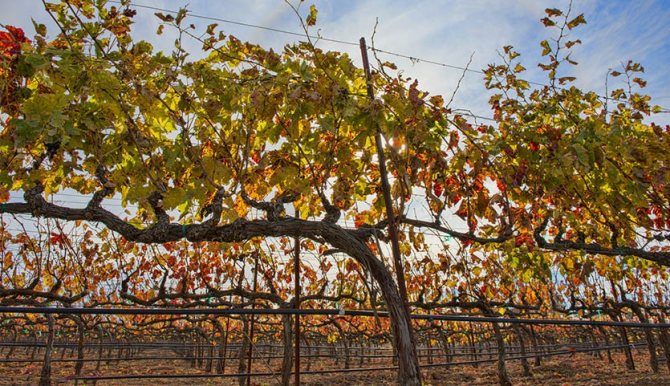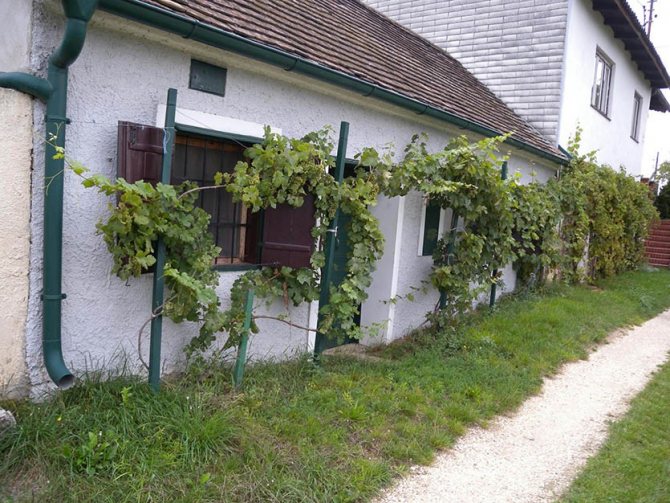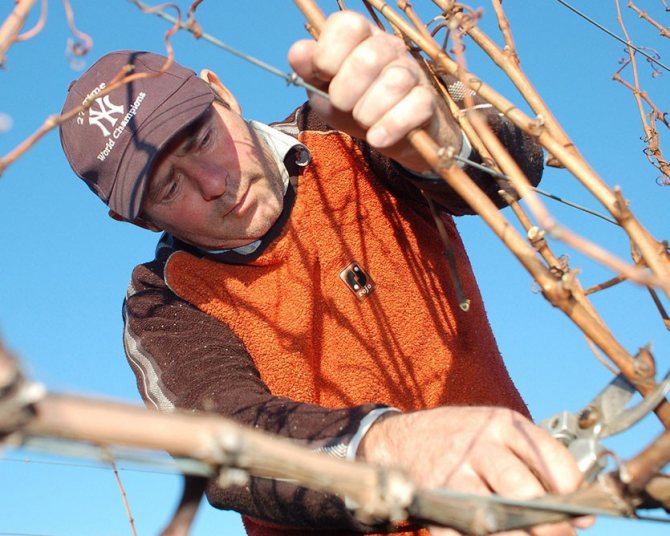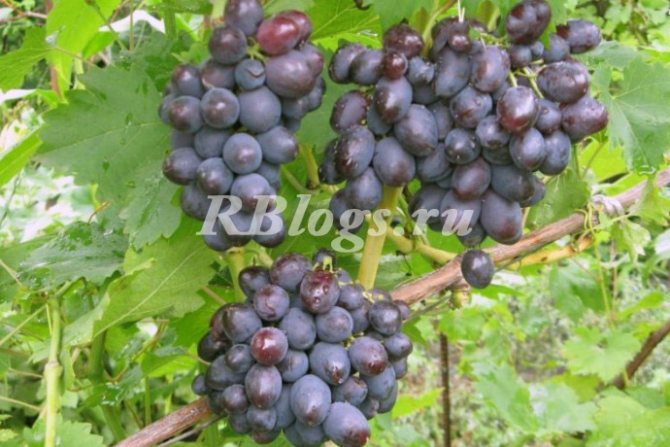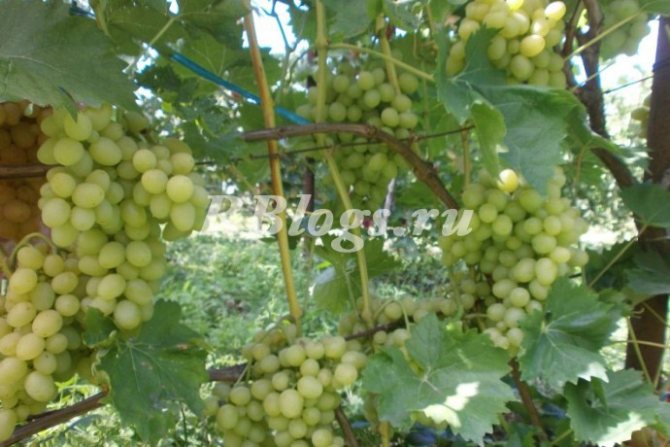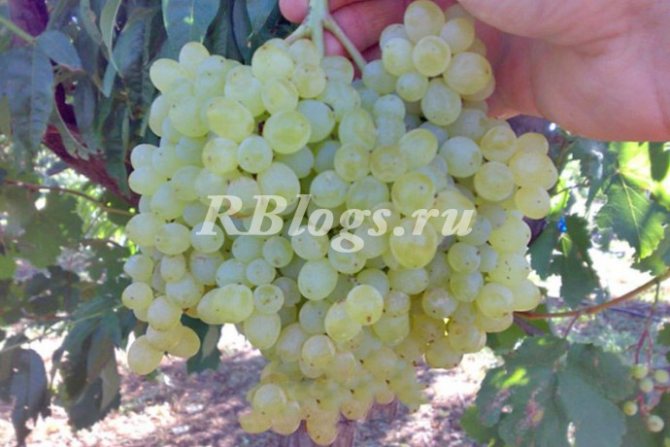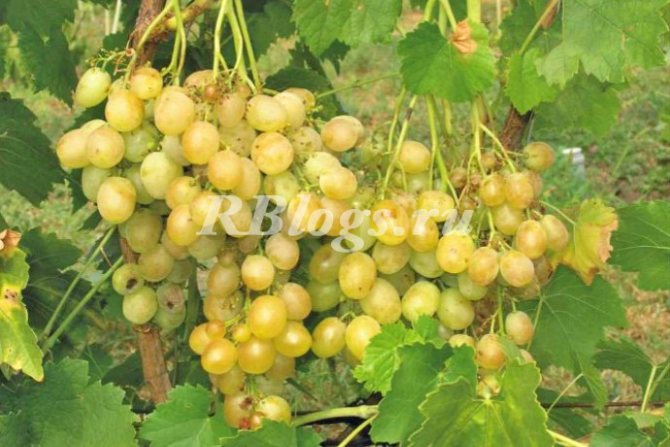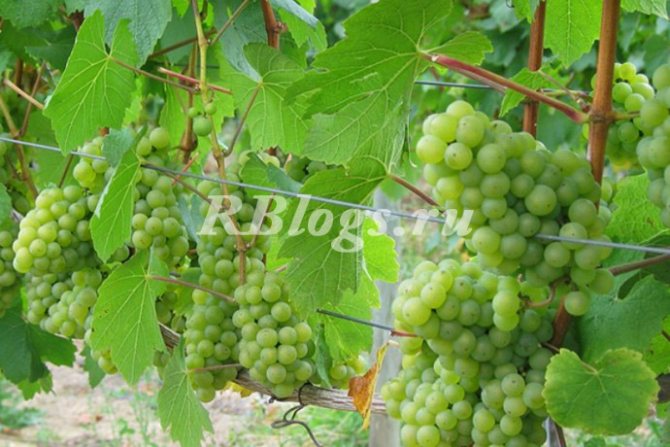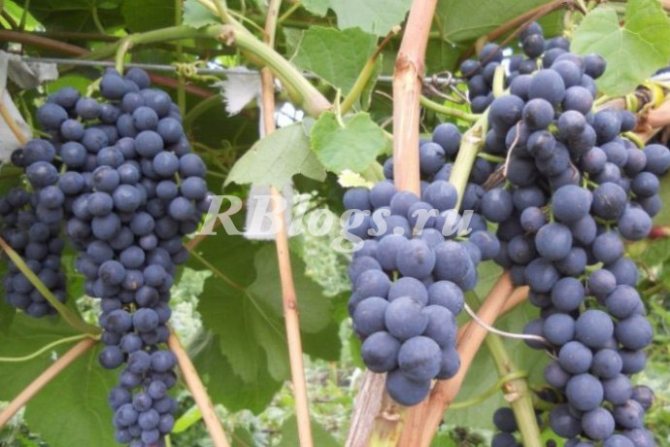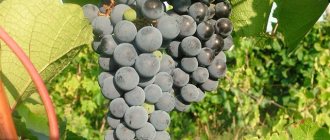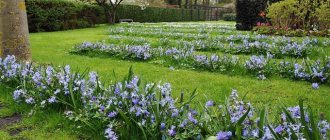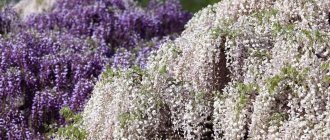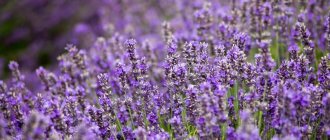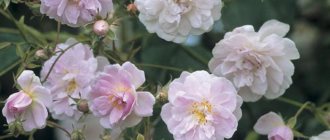Time for feeding grapes in autumn
The autumn fertilization procedure has its own time frame. It should be carried out immediately after harvesting, therefore, for early and late grape varieties, the timing of feeding will differ.
During this period, the shrub especially needs nutrients, as it begins to prepare for wintering. The level of metabolism in the plant depends on the amount of potassium and phosphorus supplied, and therefore the ability to restore your strength. Top dressing in the fall is the key to a good harvest for the next year.
An excess of fertilizers in the soil can lead to more serious consequences than a lack of them.
Benefits of autumn feeding:
- Spring moisture in the soil, enriched with useful fertilizer substances, will form a complex nutrition of the grapes.
- The growing season will come on time and go well.
- When loosening the soil during feeding, the roots of grapes receive additional care.
- Such measures are the prevention of diseases and threats from plant pests.
An experienced gardener in his video tells why and when to make top dressing for grapes:
Watering rules
If you follow all the rules of autumn irrigation, it will bring a generous harvest of berries.
Before moistening, a method is chosen in which water enters the soil and to the roots, while the stem and foliage must remain dry. Watering is carried out slowly, on loose soil into previously prepared holes, provided that there are no irrigation pipes in the ground. Cracked and dry soil is loosened in the morning, it is better to water the vineyards in the evening, the next day - to loosen the soil again.
In areas where plants do not grow under cover, water after the leaves fall. In the presence of shelters, moisture in the fall is carried out after the "warming" of the bushes. The deadlines are mid-October-early November. In autumn, the wetting of late varieties that will be stored for a long time is stopped 30 days before harvesting.
Features of watering
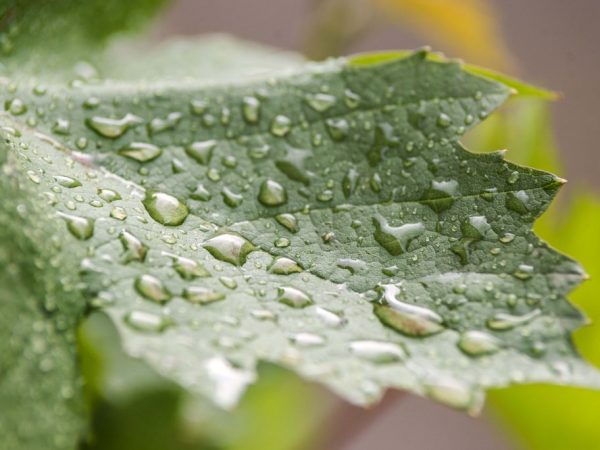
It is recommended to water the plants in the evening.
The bushes planted in rows are moistened along the furrows. With this method, the hose is placed in the furrow, the water flows until it soaks the row along its entire length. Then the hose is transferred to the next furrow.
Single bushes are watered to form pits or ditches around. Each bush has enough 7 liters of warm water. Watering is worth it in the evening, while there will be more benefits for the plants, moisture will remain better.
Irrigation of bushes from buckets provides that after adding each portion of moisture, it is worth waiting until it is absorbed, then the next portion is poured. The recesses near the bushes are removed and covered with earth: this allows you to retain moisture and ensure the flow of air.
If the vineyards are located on clay soil, water may not be absorbed, so they make punctures with a pitchfork.
Subsoil watering
One of the most effective methods is subsurface irrigation. With it, water under pressure enters the ground through the pipe system through the holes in them.
Drip irrigation
With drip moistening, the liquid enters through a pipeline or a small-diameter hose system. A positive feature of drip and subsurface irrigation is the reduction of water consumption and its combination with fertilizers.Moreover, its organization requires a special system and equipment.
Minerals for the growth of grapes
Fertilizers of the mineral composition are necessary for the life of grapes. Using them when feeding in the fall, carefully read the instructions so as not to harm the plant.
Nitrogen
In the fall, the application of fertilizers containing nitrogen is prohibited. This is due to the fact that the element stimulates the growth of young vines. All efforts are spent on this and the grapes do not have time to prepare for the winter period. Even with the first frost, the shrub may die. It is recommended to use nitrogen fertilizers in the spring.
Potash
Potassium is an essential element for grapes. It depends on him how the plant will endure the cold period and whether the next season will be productive. This element affects the formation and ripening of bunches, prevents the appearance of cracks in the fruits from an excess of moisture, helps the plant to survive drought. If there is not enough potassium for the plant, then the edges of the leaves die off.
The record holder among fertilizers in terms of potassium content is potassium sulfate - 50%. Another advantage of this top dressing is the absence of chlorine. Potassium salt contains 40% potassium, and potassium magnesium - 30%. Combine potash dressings with phosphoric ones.
Phosphoric
Phosphorus, accumulating in the tissues of grapes after the autumn application to the soil, promotes flowering and the formation of ovaries and rich brushes. Simple superphosphate contains 21% phosphorus, is suitable for various types of soil and is easily soluble in water.
Acidified soils should be limed by adding chalk, limestone or other slightly alkaline components to the superphosphate. It is the most popular phosphate fertilizer.
In double superphosphate, potassium is present in an amount of 50%. It differs from the previous product in the absence of gypsum in the composition.
Phosphorite flour is consumed in large volumes, since the content of phosphorus oxide in it is up to 23%. This type of fertilizer has an effective effect on acidic soil for a long time.
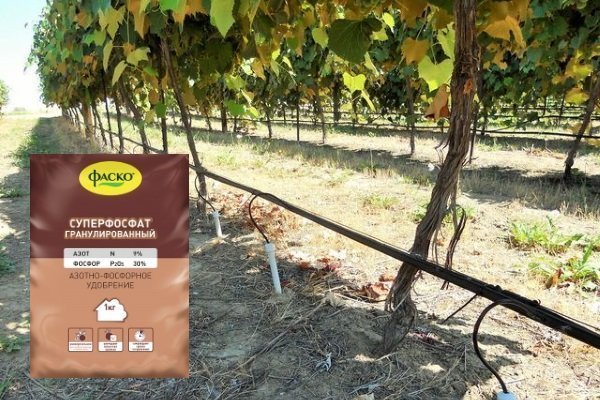

Complex
Complex fertilizers are created by chemical reaction of elements or by simple mixing of monofertilizers. In addition to nitrogen, potassium and phosphorus, they contain additional components. For example, zinc and copper increase the yield of grapes. Such dressings include Nitrofoska, Nitroammofoska, Rost-1, Florovit, etc.
Since the composition of complex fertilizers contains nitrogen, they must be applied in the spring, according to the state of the plants - in the summer. To prepare grapes for wintering, their use is undesirable.
How the culture is fed
Various minerals have an impact on the vital functions of grape bushes. Nitrogen stimulates the growth of green parts of the plant. Phosphorus provides a healthy and abundant flowering and fruit setting. Without magnesium, photosynthesis and protein formation do not occur. Zinc increases the abundance of fruiting, and boron accelerates the ripening of fruits, affects their weight and taste. Potassium increases resistance to frost and temperature extremes.
Grapes require less nitrogen than other horticultural crops. Other elements are much more important for the plant.
Root and foliar feeding is carried out with minerals throughout the year. Organic matter is applied less often when there is a need to improve the structure and fertility of the soil.
Mineral dressing
Before wintering, grape bushes must be treated with phosphorus and potassium dressings. You can use a complex preparation, which also includes magnesium, zinc and sulfur. The top dressing should not contain chloride ions: the plant does not tolerate chlorine ions.
When the harvest ripens in the Moscow region: in summer or autumn
The main harvest in the Moscow region is carried out in late summer - early autumn. By this time, the berries have time to ripen.Overexposing the fruits on the bushes is not recommended, they lose their taste. Taking care of grapes in August in the Moscow region means pruning, removing spoiled leaves, collecting pilaf and inspecting all shoots.
Grapes can be grown in the suburbs, subject to certain rules. If desired and properly cared for, you can get a wonderful harvest with excellent taste.
{SOURCE}
Organic fertilizers for grapes
If mineral fertilizers were applied in spring and summer, then it is preferable to use organic fertilizers in the autumn.
Ash
The most suitable organic fertilizer for grapes is ash. There is no nitrogen in it, so such feeding cannot harm in the autumn-winter period. And the abundant phosphorus, magnesium, calcium and potassium will help prepare the plant for wintering.
The accumulation of nutrients and the overgrowth of young shoots with bark will protect them from winter bad weather. The richest in elements is ash from sunflower seeds.
The amount of the main component in it depends on the type of ash:
- coniferous ash - rich in phosphorus;
- deciduous - potassium.
In dry form, such dressing is used when digging a grape plantation.
To prepare the ash solution, follow these steps:
- Pour 300 g of ash with 10 liters of water;
- insist for about a week, stirring the infusion periodically;
- make a depression no more than 10 cm around the grapes;
- pour the infusion into the groove at the rate of 5 liters for each bush.
The video presented tells about the introduction of ash under the grapes:
Compost
Decayed plant residues are rich in their composition of trace elements. For feeding, mix compost with peat. Place this mixture directly under the vine bush in a layer of at least 5 cm. Sprinkle with soil.
You can put plant residues in a container and fill with water. In the process of overheating, minerals will be released, which, with irrigation, will pass into the soil.
Benefits of compost:
- makes the soil loose;
- inhibits the growth of weeds;
- retains moisture in the soil.
Bird droppings
Bird droppings contain a large amount of trace elements in an easily accessible form. It reduces the acidity of the soil, saturates it with beneficial bacteria. It takes time for nitrogen to be released from the fertilizer and get into the root system. That is why it is advisable to introduce litter in the fall.
Chicken manure is used as a solution or dry. To prepare a liquid top dressing
- add water to the litter in a ratio of 1: 4;
- put in a warm place for 10 days;
- dilute with infusion with water in a ratio of 1:10;
- pour between rows at the rate of 500 ml per bush.
Do not pour the solution directly under the grapes, so as not to burn the root system.
It is recommended to water the soil before and after top dressing to ensure that the top dressing is quickly absorbed into the soil. The procedure for introducing poultry droppings is carried out 1-2 times a year.
Manure
Manure (mullein) supplies grapes with potassium, phosphorus and nitrogen, saturates the soil with beneficial bacteria. Wastes of vital activity before feeding need time to perepilat. Then manure is mixed with compost, and the resulting composition fills the furrows in the aisles of the vineyard.
How to care after landing
Taking care of grapes in the Moscow region in summer and autumn is very important. If some rules are not followed, you can not only be left without a crop, but also lose the plant completely.
Top dressing and watering
During the development period, the grapes need to be watered on time, but not to allow waterlogging of the soil. Water should penetrate 50 cm into the soil, 10 liters of liquid per week is enough for each bush.
Various mineral fertilizers are used for feeding. For acidic soil, alkalizing substances are chosen and vice versa. During the season, at least 4 dressings are carried out, if pests are present, as needed.
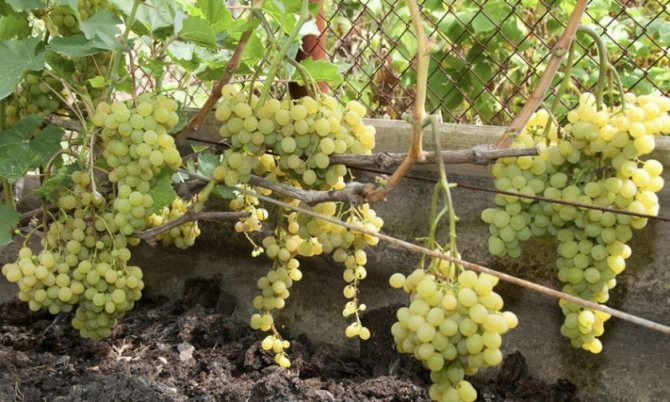

Spraying
Grapes are very sensitive to a lack of magnesium in the soil. A similar phenomenon contributes to the death of the plant. The grapes are sprayed every 2 weeks with a mixture made from a bucket of water and 250 g of a mixture of magnesium and sulfur.
Prevention of pests and diseases
Grapes in the Moscow region are prone to diseases such as powdery mildew, gray and white rot. For the purpose of prevention, the plant is treated with iron vitriol, urea, and special fungicides. Be sure to carefully monitor the grapes throughout the season and, if necessary, take immediate action.
Important! Before wintering, foliage is removed, pruning is carried out in a timely manner.
Forming and pruning a bush
To increase yields, superfluous and sterile shoots are completely removed on the bushes. The first pruning is carried out during the period when the buds of inflorescences appear, the second - after the plant has faded. Shoots can be removed with pruning shears or simply broken off at the base.
During the period of strong growth, the tops of the shoots with underdeveloped leaves are pinched. The first time this is done when the sprout has reached 25 cm, the second - at the beginning of flowering.
If necessary, pinching is carried out - the removal of lateral shoots that have grown from the buds of the current year.
Features of fertilization of young and old grapes
If fertilizers were used when planting young grapes, then in the next 2-3 years no additional fertilizing is required. From the third year, organic matter is used first, and then mineral supplements. Proper fertilization increases the frost resistance of grapes, is a preventive measure against diseases and pests, and enriches the soil.
Before wintering, old grapes are saturated with phosphorus-potassium fertilizers. The formed bark on the stems and a sufficient amount of minerals help the plant to survive frost without shelter. And in spring, a healthy bush will actively enter the growing season.
Mulching


Fertilized vineyard is well spilled. This is a mandatory procedure before wintering plants. To preserve the water and the added top dressing, the trunks are mulched before the onset of frost.
For this operation, you can use needles, cut grass, humus. This covering of the surface also additionally fertilizes the grapes. Moreover, the intake of nutrients occurs gradually.
Fertilizing an Autumn Vineyard:
Useful Tips
To carry out high-quality and effective autumn feeding of grapes, you should heed the following tips:
- In order for the fertilizers to be absorbed by the main root system, dig circles around each bush with a radius of 0.5 m and a depth of 35-40 cm. Do not be afraid of damage to the roots - they will quickly recover. If fertilizing is applied directly to the surface of the soil, without making depressions, they will be absorbed by the upper roots, and not by the main ones. This will lead to their branching on the surface, rather than strengthening at a depth and during the winter, the roots will freeze.
- Abundant watering in October, after harvest, will help the accumulation of nutrients in the grapes and protect it from low temperatures. In addition, the accumulation of potassium will prevent the fruit from cracking in the next season. It makes no sense to fill the plants. It is enough to maintain the moisture content of the soil, focusing on the weather conditions. The amount of water required for irrigation is also determined by the type of soil - in sandy soils, grapes need up to 70 liters for each bush, and in clay soils, 20-25 liters are enough.
- After the autumn pruning and feeding, it is necessary to spray the grapes to prevent diseases and pests.
The use of autumn feeding of grapes will help not only to saturate the plant with useful elements, but also to prepare it for the coming winter. The bush will bear the cold much easier, and in the spring it will spend less energy on recovery.
0
Autumn pruning in front of shelter
Why is it better to prune grapes in the fall? If this is done in the spring, a liquid - "juice" will flow out of the slices. It will take time for the bush to recover, the vegetation slows down by about two weeks. Accordingly, the harvest will ripen later.
Pruning can only be started after complete flying around the foliage. Even damaged, semi-dry leaves continue to nourish the bush with useful substances. It is advisable to carry out the procedure in dry weather. The correct time for autumn pruning of grapes before shelter for the winter depends on the region and the actual weather, in the Urals and Siberia it can be September, in the Moscow region - October, in the Krasnodar Territory - November.
Not only beginners, but also experienced growers often neglect the processing of the pruner during pruning. When you need to process a lot of bushes, it is a pity to waste time wiping. But this is really dangerous. Different grape varieties have different resistance to infections. An infected vine with high disease resistance will not show anything outwardly, but it will be the source of the disease. During pruning, the infection will spread to the rest of the bushes, some of them will not be able to fight, it will not be easy to cure the disease.
In order not to waste time wiping the secateurs, we prepare a disinfectant in advance, based on alcohol, pour it into a jar. Having finished trimming one bush, we dip the tool into the solution and continue working.
Protection against diseases and pests
An important process of caring for grapes in the fall and preparing for winter is the preventive protection of the vine. The choice of a spray product depends on the condition of the vineyard:
- If, during the inspection, traces of mildew are revealed, the affected shoots with leaves are cut off and burned. The vineyard is sprayed with "Folpan", "Ridomil" or another similar preparation.
- If signs of oidium are detected, the vine is sprayed with any preparation containing sulfur even before dropping the foliage in early autumn.
- Against anthracnose, drugs used to treat oidium and mildew are used.
- When, when examining the grapes in the fall, traces of a leaf roll are found, the bush is treated with a decoction of tobacco or medicinal chamomile.
- The raining of berries and bunches in early autumn may be associated with cercospora. The disease still manifests itself as brown spots on the leaf plates. For the care of a sick vineyard, use "Fundazol". "Polychoma" helps a lot.
- In the fall, ticks like to get along on the vine. Most often, they sit on the tops of young branches. A measure of getting rid of the pest is pruning the tops of the shoots.
- In the case of the development of gray rot in autumn, the processing of the culture is carried out with "Euparen" or the preparation "Skala".
Healthy bushes also need preventive care. The vineyard is sprayed in late autumn after leaf fall with a 3% solution of copper sulfate.

